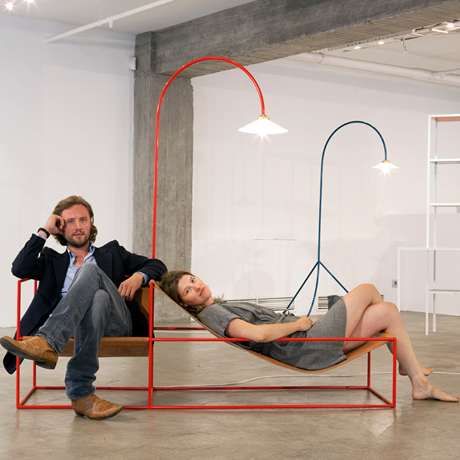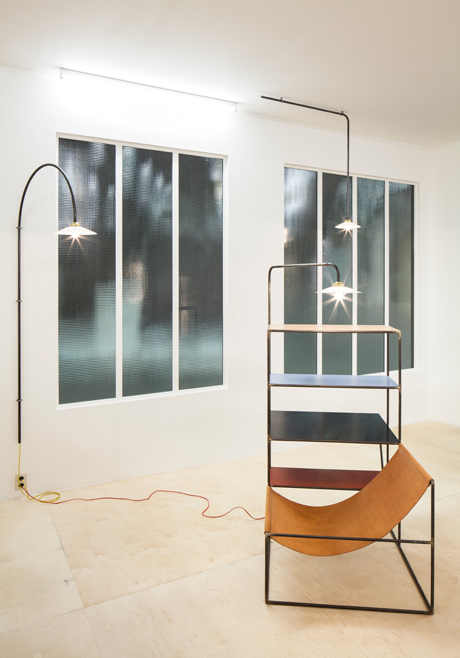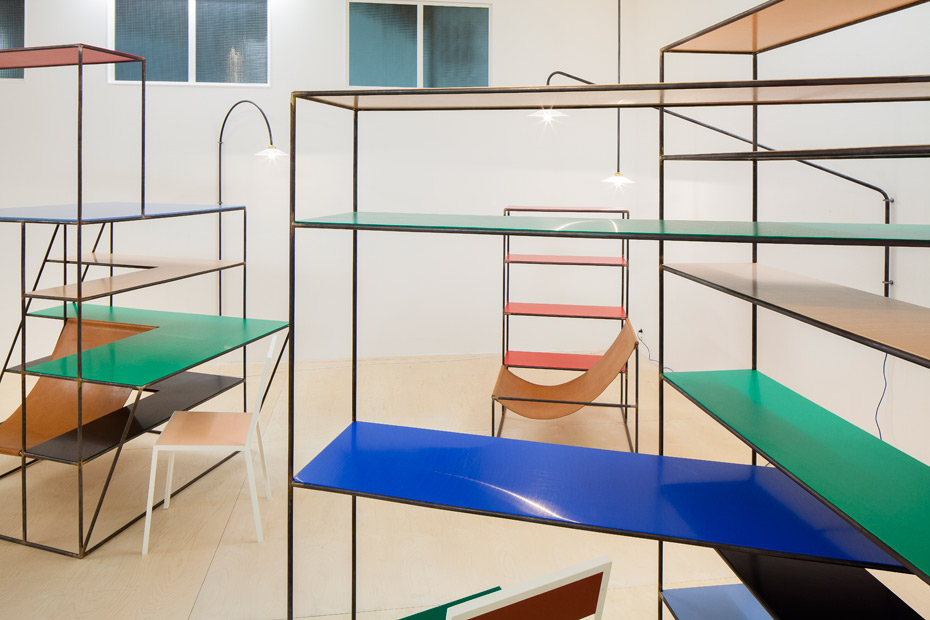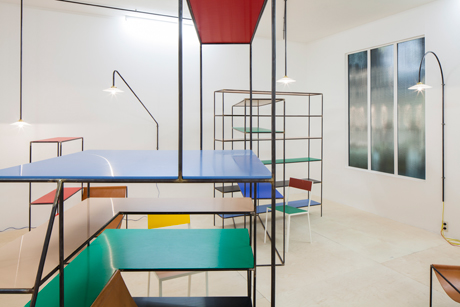- Betty Wood speaks to Belgian designers Fien Muller and Hannes Van Severen about how they spark off each other, and the logic of their designs
 Left to right: Hannes Van Severen and Fien Muller
Left to right: Hannes Van Severen and Fien Muller
Photograph Fien MullerIt was a revolutionary shake-up for this year’s Interieur when president and curator Lowie Vermeersch announced they would be getting rid of the traditional guest of honour spot, and replacing it with seven separate Project Rooms. Featuring the work of internationally acclaimed designers Ross Lovegrove, Nendo, Troika, Makkink & Bey, David Bowen, Greg Lynn and Muller Van Severen, these spaces explore this year’s theme Future Primatives.
Belgian designer duo Fien Muller and Hannes Van Severen were chosen by Vermeersch as the home-nation representatives. Using material as their starting point, their furniture is both playful and practical, with simple forms that focus on facilitating togetherness: a simple bookcase becomes also a desk, chair and light source. The traditional sofa — designed to focus attention outwards, say at a television set — is reconsidered: Muller Van Severen’s sofa enables conversation whilst maximising space by having the seats parallel, but inward facing.

- Betty Wood: You’re a couple as well as collaborative business partners: how did you start designing furniture, and how long have you been working together?
Fien Muller: Not even two years…
Hannes Van Severen: In May it will be a year and a half. We work as physical artists and we just decided to make furniture together — we wanted to do something else. It was very natural: we always loved furniture. I’m from a design family, my father was a designer and I’ve always loved design. This was the first time we had thought about it together.
Fien: It came very naturally.Betty: Is there a cut off between your private and professional lives?
Fien: There are a lot of people who say this to us: “Ughh! Together all the time? How do you do it?”
Hannes: We get on really well. We like and hate the same things. We know what will be good, what works and doesn’t.
Fien: We’ve been working as visual artists for ten years, and then coming together with this has given us a lot of energy and movement. And because the furniture is there [in our space], I find it influencing my individual work too.Right: Muller Van Severen Project Space, armchair with shelving unit and lamp, courtesy of Frederik Vercruysse

 Betty: When you’re working on a project together, do you have assigned roles or do you do everything collaboratively?
Betty: When you’re working on a project together, do you have assigned roles or do you do everything collaboratively?
Fien: No, we don’t have a structure.
Hannes: We have to travel so it can get very hectic! We work between cooking ; we are always thinking of things! One of us will do a drawing and the other will take the idea…
Fien: Or we might see a colour in a shop or a market… We’re always talking. During day-to-day life, we always see things and try to assimilate and the materials we like into our work.
Hannes: We draw things too. Say I have an idea of how this should be a good object — one of us will change it a little bit.
Hannes: If we think it’s good we’ll start to make a rudimentary prototype, which we put together very brutally to see how the proportions work — whether things need to be bigger or smaller.
Fien: (Nodding) More like sculpture —Hannes: Yes, we work like sculptors. We like to work from materials that already exist; the last thing we made was with L-type profile iron. We like to combine things like this it with another standard material, like a 2cm thick plate, put together very simply. We don’t like to manipulate things too much. Like the ladder, we just let it hang behind two bars, and the form shapes itself, just by hanging. The materials we use are just the materials we find in the woods.
Fien: Assemblage. The frame is very strict and rational. Then you have interpretation — its form, its place, whether it’s colourful — that comes through in all our objects in a poetic way. I think that’s important.
Hannes: They’re minimalistic forms and lines that we have, but what we do with it is very poetic and warm.Above: Muller Van Severen’s furniture is a mix of iron, polythene planks and leather. Courtesy of Frederik Vercruysse

- Betty: You’re both practicing artists: is there a line between design and art?
Fien: For me, it’s not important. I think design can be art, and art can be design. I don’t like to categorise them.
Hannes: (Shakes head) For me art is something that has no function.
Fien: (To Hannes) Why should function not be ‘art’?
Hannes: I guess art does have another meaning, other than just hanging on the wall and being nice… I don’t know — it’s difficult. (Laughs) But I don’t like furniture that has a complex form that’s meant to be art… start from thinking of a form, and not of sitting. We start from material most of the time.
Fien: For me it’s not important if you like it or not, or even if you see it as an art object: some people will and some people won’t. For me it’s about your interpretation, and your way of thinking about it — it’s open.
Hannes: We like to make something with many dimensions, that’s why we do things together, more functions together, to create something in space…
Fien: We like to make sculpture that can be used. As we are active visual artists and used to making art, it’s very natural to do that, to make. With the added complexity of the functionality of the furniture, that can be very interesting.
Hannes: In art you can do anything, but with furniture or design you have limitations.
.Top right: “I always liked Mondrian, and I think you can see that with the plates, and the lines” — Fien Muller
Courtesy of Frederik Vercruysse Betty: You’ve talked about your influences being the Bauhaus School as well as the work of your father, Maarten Van Severen, Hannes: how do you innovate from your influences?
Betty: You’ve talked about your influences being the Bauhaus School as well as the work of your father, Maarten Van Severen, Hannes: how do you innovate from your influences?Fien: We work very instinctively. Of course we have influences — they show themselves naturally. Our work is very transparent. Between the lines there is a lot of space. I always liked Mondrian, and I think you can see that with the plates, and the lines. We like drawing in the space. My father was in antiques, and I saw a lot of drawings growing up… A lot of our inspiration is from our childhood I think.
Hannes: My grandfather also was a minimalist artist and he way always painting lines. Sometimes it’s very difficult to describe where this or that came from: we make things with our gut, and sometimes things are difficult to explain.
Hannes: It’s also thinking about how we can live together and how we can live in the future.

- Betty: The focus of this Biennale is very much on the future: how, as designers, do you think the current economic climate is affecting design?
Hannes: It’s acting like a filter. There’s always creativity when there is not a lot of money. I think it’s very interesting. When artists get money from the government, sometimes they start to get lazy — they get comfortable. I think that your brain works harder [if you’re not comfortable]. Things are more honest if they need to do the thing they have to do.
Fien: Yes. It’s democratic: everyone is on the same level of discovery.See the Muller Van Severen Project Room at the 2012 Interieur Biennale, Kortjik until 28 October
Subscribe to Port Magazine annually and receive each issue to your door.
Get PORT in print



